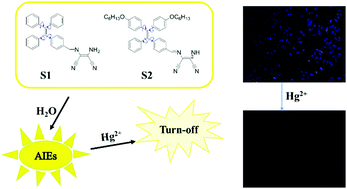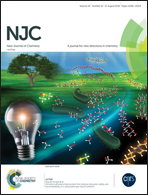Fluorescence probes based on AIE luminogen: application for sensing Hg2+ in aqueous media and cellular imaging†
Abstract
Two novel fluorogenic probes (S1 and S2) containing AIE luminogen and Schiff bases with high selectivity toward Hg2+ over other metal ions were developed in aqueous solutions and living cells. They showed remarkable aggregation-induced emission enhancement and the fluorescent emission of S2 was stronger in almost pure water due to the introduction of two oxyalkyl chains and longer conjugation lengths. More importantly, both S1 and S2 have been successfully applied for Hg2+ detection in aqueous solutions with low detection limits (LODs), and S2 could be applied for the detection of Hg2+ by the naked eye. The detection limits of S1 and S2 for Hg2+ were calculated to be 19.4 and 9.84 nM (<2 ppb), respectively. Furthermore, [S1, S2] + Hg2+ sensors were found to be active in aqueous media with wide ranges of pH values (about 5.5–12). In addition, biological imaging demonstrated that S1 and S2 could act as turn-off fluorescent chemosensors for Hg2+ in living cells, but the effect of S1 was more significant, which was contrary to its effect in aqueous solutions.



 Please wait while we load your content...
Please wait while we load your content...